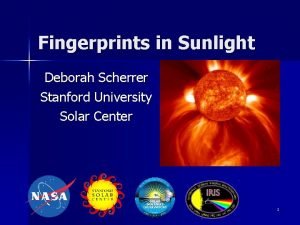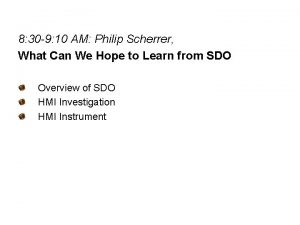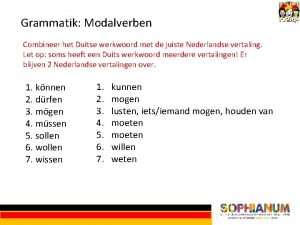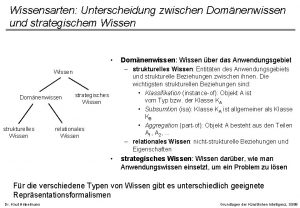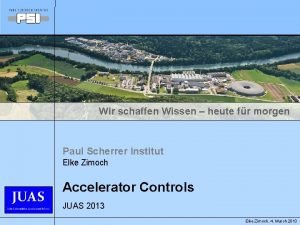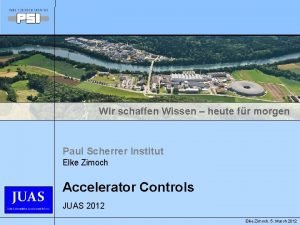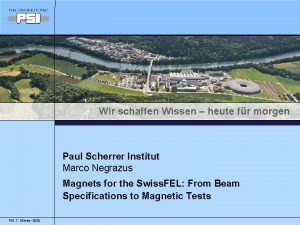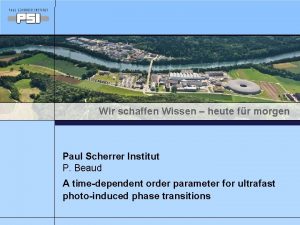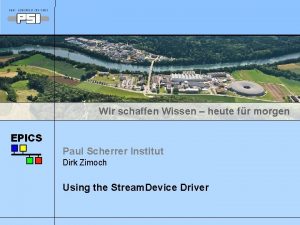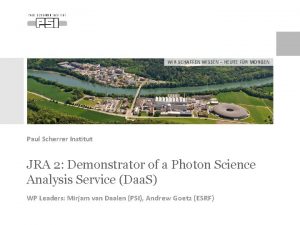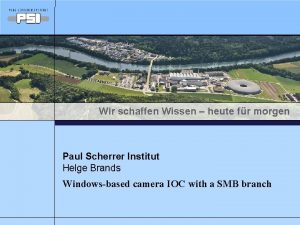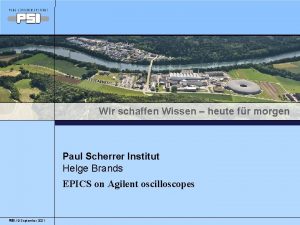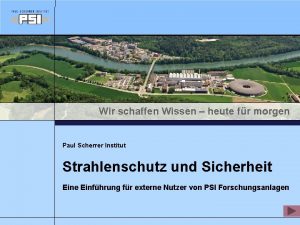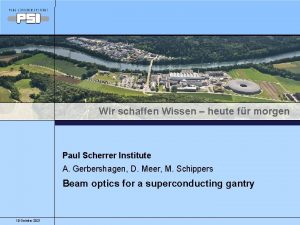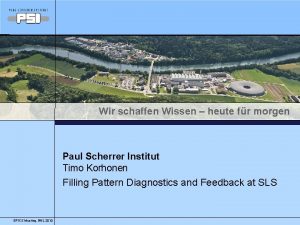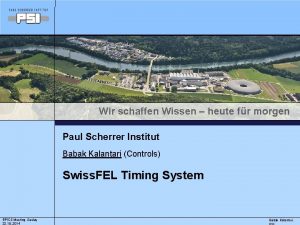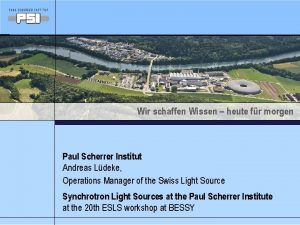Wir schaffen Wissen heute fr morgen Paul Scherrer







![Swiss. FEL synchronization [Swiss. FEL Conceptual Design Report, Update, March 2011] Developed by diagnostic Swiss. FEL synchronization [Swiss. FEL Conceptual Design Report, Update, March 2011] Developed by diagnostic](https://slidetodoc.com/presentation_image_h/27f3644204bbc1f9fe0354a9cc84f0b2/image-8.jpg)



















- Slides: 27

Wir schaffen Wissen – heute für morgen Paul Scherrer Institut Paul Beaud Pump laser: opportunity and challenges PSI, 06 06 März 2021

Swiss. FEL: view from the experiment 1. Pump laser: ‘work horse’ 2. Beamline/experiment: ‘taylor’ required pump pulse 3. Time-resolution: synchronization & arrival time monitors

1. The work horse State of the art Ti: Sapphire CPA laser system - Robust, emphasis on long-term stability - 800 nm, ~20 m. J, 100 Hz, 30 – 40 fs - Good spatial mode - Time-bandwith limited - Synchronized to Swiss. FEL Laser companies: Coherent, KML, Amplitude, Thales, . . .

The work horse How many lasers? - At least two, preferentially three: 1. for running experiment 2. for preparing experiments at the other endstation(s) 3. in reserve for emergencies, - Some pump-lasers and other vital stuff in reserve for rapid exchange Many reasons to use diode-pumped pump-lasers - Stability, lifetime, no continuous tweaking needed - No thermal lensing → good & stable spatial mode - Low power consumption, less heat, no high-pressure cooling loop, . . . Who is responsible for pump lasers ? - Tweaking, maintainance & repairs - Group of laser physicist, engineers (? ) - GFA laser group (? ) → synergy effect - No postdocs or beamline scientists should take care of this

Laser: Environment Laser hutch Must be on same floor than FEL Large enough for 2 – 3 lasers Temperature 22 ± 0. 2 °C - Pressure stabilized (? ) Humidity < 35% Clean room Issues: - Pointing stability & synchronization - vg changes with air p, T &, humidity ~ 60 m airpath inside laser system yields drifts of d. T ≈ 1 °C → ~ 150 fs dp ≈ 20 mb → ~ 850 fs Why take the risk?

Drifts at FEMTO - Time resolution typically < 200 fs (averaged ove many hours) - Time resolution ~85 fs rms - Drifts over a week ~ 30 fs rms Beaud et al. PRL 99 174801 (2007)

Jitter of FEMTO-laser - Cross-correlation between FEMTO pump laser (~110 fs) with home built Yb fiber laser (6 o fs), both synchronized to SLS 500 MHz RF → jitter ~50 fs rms - Includes contributions from both oscillators, FEMTO amplifier & vibrations from ~ 40 m transport line to X 05 DA diagnostic hutch Felix Müller et al. Proc. DIPAC’ 09 → Should be much better using optical reference developed at Swiss. FEL (jitter & drifts < 10 fs rms)
![Swiss FEL synchronization Swiss FEL Conceptual Design Report Update March 2011 Developed by diagnostic Swiss. FEL synchronization [Swiss. FEL Conceptual Design Report, Update, March 2011] Developed by diagnostic](https://slidetodoc.com/presentation_image_h/27f3644204bbc1f9fe0354a9cc84f0b2/image-8.jpg)
Swiss. FEL synchronization [Swiss. FEL Conceptual Design Report, Update, March 2011] Developed by diagnostic group (Volker Schlott et al. )

Oscillator synchronization in devlopment < 8 fs demonstrated Fiber link stabilization based on single-crystal balanced cross correlator → use same technique to synchronize oscillator → < 10 fs? [Kim et al. Opt. Lett. . 32 1044 2007]

Hutch temperature & pointing stability

Challenges: Experiment At the beamline we will need to implement some general tools: - Optical parametric amplifiers (OPA) - noncollinear OPA - intense single cycle THz pulses -. . . and proper diagnostics More challenging tools need to be designed and prepared for each individual experiment: - pulse compression - multicycle THz - pulse-front tilting of pump pulse -. . . Challenge: short turn around time between experiments

Generate pump-pulses for experiments Frequency conversion based on parametric optical amplification covers spectral range from ~200 nm – 20 mm TOPAS prime, Light Conversion Inc.

Shorter pulses: noncollinear OPA‘s < 10 fs (FWHM) feasible in the visible & NIR spectral range

Shorter pulses: compression techniques

High field single cycle THz pulses Hauri et al. Appl. Phys. Lett. 99 161116 (2011) Organic crystals DAST, OH 1. . . - Fields > 1 MV/cm demonstrated - Requires pump between 1. 2 – 1. 6 mm Li. Nb. O 3 - Frequency limited to lower THz range - can be pumped at 800 nm, but requires tilted wave front scheme

Tunable, multicycle THz pulses - Use multiple equally spaced input pulses - Demonstrated at low fluence, few cycles & low THz - Challenging task to extrapolate to higher frequencies, high fluence and small bandwidth - 1% bandwidth ~ 100 pulses needed - Alternative: Small accelerator + undulator (d’Artagnan) Feurer et al. Opt. Lett. 29 1802 (2004

Setup challenges Problem: Mismatch of laser excitation /x-ray probe depth thin film or grazing incidence diffraction - Grazing incidence allows matching of x-ray probe laser-excitation depths - Requires tight foucsing of x-ray beam - Pump laser incident at 10°, close to Brewster angle (p-plarization) - Problems: - For birefringent samples - No freedom to choose pump polarization - Difficult with highly dicergent THz beams

Setup challenges Pump laser X-ray probe - To freely vary polarization, want normal incidence - Depth matching: X-rays grazing (0. 5 degrees) - Solution: pulse front tilt by 45 degrees

Realization APD Hebling et al. , Opt. Expr. 10 1161 (2002) Vacuum λ/2 plate sample Impulsive excitation of symmetry breaking phonon mode (Bi) Johnson et al. manuscript in preparation

THz: setup & diagnostics Example SXR experiment in July 2012 (PI Urs Staub, PSI): Modification of UHV chamber required to accommodate THz pump & e-o sampling diagnostics

Separate laser laboratory - To setup new ‘pump’ tools for ESB experiments - Nice to have for in-house research - Keep FEMTO hutch at SLS? Will need upgrade and/or new laser - Laser must have similar parameters as the pump-laser

Synchronization Laser - Oscillator(s) synchronized to pulses optical reference (<10 fs) At the beamline/experiment - Additional cross-correlation between ‘optical reference’ & ‘pump-pulse’ to measure jitter & drifts from vibrations, amplifiers … Electron bunch arrival time measurements - Preferentially after undulator section - Sufficient for many experiments X-ray time arrival measurements - Required for highest resolution < 10 fs - Shot-to shot X-ray/laser crosscorrelation needed

Electro-optical bunch arrival monitor EO BAM Principle: mod. OMO laser pulses EOM pick-up sig. FO RX : - misalignment betw. laser pulses & pick-up signal modulates pulse amplitude - opt. delay line position indicates pulse misalignment (tune until AM=0) pickup voltage Design & Results from DESY (courtesy of F. Löhl) time error laser pulse modulation: error unmodulated bunch too early bunch in time (calibration) bunch too late BAM Resolution (by correlation of 2 BAM measure Resolution: estimated from OMO laser amplitude noise and pick-up slope steepness to < 10 fs Resolution: correlation of 2 BAMs 8. 4 fs rms single BAM short term ~ 6 fs (rms)

EO BAM developments at Swiss. FEL V. Arsov, M. Kaier, S. Hunziker, P. Chevtsov, G. Marinkovic, V. Schlott Highly Stable OMO Reference 3. 3 fs (rms) jitter (1 k. Hz – 10 MHz) Swiss laser: ORIGAMI from One. Five (CH) High Bandwidth BAM Pick-Up: Other Components (selected and presently under test): → improved ADC readout (16 bit, 150 MS/s) → high resolution linear motors for delay stages → high resolution (10 nm) linear encoders for link sta and BAM signal detection BAM Design Goals: < 5 fs (rms) resolu → ultra-fast slew rate (~ 3 V / ps) → ridged waveguides for low charges (~ 20 V Beam / ps) Arrival Time: < 10 fs (rms) jitter

Time resolution Regular time resolution ~30 fs rms - Pump pulse jitter < 20 fs rms should be feasible - Electron beam arrival monitor after undulator section < 20 fs (GFA Diagnostic Group) - Sufficient for many experiments < 10 fs time resolution - Challenging - Shot-to shot X-ray/laser cross-correlation needed → 13: 45 - 14: 30 Marco Cammarata “ 10 fs arrival time monitor and single shot spectrometers for hard x-ray FELs”

Challenges. . . Pump-laser - Conservative & robust, diode-pumped pump lasers - Maintainance & repairs by a laser group - Stable environment essential to reach targeted time resolution Pump-pulse ‘tayloring’ - Optical table close to experiment - Regular beamline equipment: OPA’s, NOPA’s, single cycle THz. . . - More demanding setups: Postdocs in collaboration with users - Unsolved challenge: narrowband, tunable 0. 1 – 20 THz pulses - Need separate laser lab to prepare all this Synchronization - Regular time resolution of ~30 fs rms should be feasible with e-BAM - Less than 10 fs resolution, challenging, requires single shot x-ray/laser cross-correlation

. . . and opportunities Many technical challenges, but many opportunities for new science. Acknowledgements Steven Johnson, Gerhard Ingold, Urs Staub, Chris Milne, Volker Schlott, Ekaterina Vorobeva, Simon Mariager, Jeremy Johnson, Andrin Caviezel, Sebastian Gruebel, …
 Wir schaffen das raute
Wir schaffen das raute Zylinderprinzip
Zylinderprinzip Ein neuer tag beginnt bilder
Ein neuer tag beginnt bilder Was du heute machen kannst verschiebe nicht auf morgen
Was du heute machen kannst verschiebe nicht auf morgen Wenn du ein dach über dem kopf hast
Wenn du ein dach über dem kopf hast Heute mittwoch guten morgen mittwoch winter
Heute mittwoch guten morgen mittwoch winter Unser büro heute und morgen
Unser büro heute und morgen Was haben wir heute
Was haben wir heute Wievielten haben wir heute
Wievielten haben wir heute Wir sind nicht mehr was wir mal waren
Wir sind nicht mehr was wir mal waren Zünden wir ein lichtlein an
Zünden wir ein lichtlein an Zünden wir ein lichtlein an
Zünden wir ein lichtlein an Solar center stanford
Solar center stanford Phillip a. scherrer
Phillip a. scherrer Dr philip scherrer
Dr philip scherrer Ilse wenzl
Ilse wenzl Wissen prapositionen
Wissen prapositionen Es ist nicht genug zu wissen
Es ist nicht genug zu wissen Was wissen sie über deutschland
Was wissen sie über deutschland Bescheid wissen
Bescheid wissen Individuelles wissen
Individuelles wissen Departement bildung, kultur und sport
Departement bildung, kultur und sport Modalverben wollen
Modalverben wollen Strukturelles wissen
Strukturelles wissen Wann hast du geburtstag?
Wann hast du geburtstag? Guten morgen ruft die sonne
Guten morgen ruft die sonne Grüβ gott
Grüβ gott Kww hww zww
Kww hww zww












